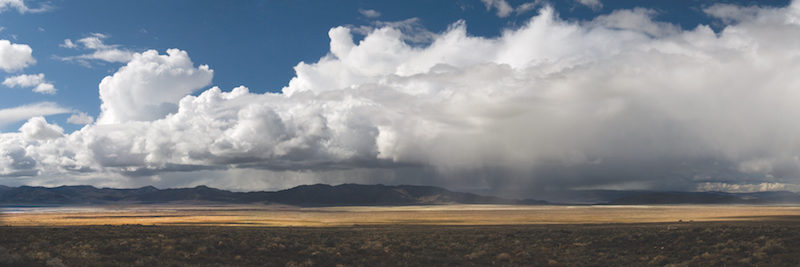The Middle of Nowhere
Climbing nowhere can put you exactly where you need to be.
BY LEATH TONINO
There is no road, hasn’t been a road since Gerlach, Nevada. That crust of a town where we turned from pavement to playa to hairline-fractured hardpan, and the truck transcended its truckness to become one with the earth. Dust swings left and right in the rearview mirror, a brown tail whipping into oblivion the memories of Reno’s traffic and Fernley’s crowded Walmart parking lot. The dust erases and welcomes. The dust coats tongues. Ancient Lake Lahontan’s parched floor is at once beneath our tires and in the air.
The four of us—childhood friends from Vermont, high school brothers scattered to various corners of the country, so-called grown men—don’t give a fat flying hoot about next month’s Burning Man festivities which take place here. We’ve made the pilgrimage to the Black Rock Desert not for 60,000 humans, not for lasers and whumping bass and skyscraper flames, but for the desert’s own severe weirdness. Its isolation. Its fierce summer heat. Specifically, we’re interested in the trailless maze, the jumbled volcanic mess, that is King Lear Peak’s west slope.
Sweat out the sins of a well-lived life, says somebody, raising a toast to tomorrow’s climb.
Click, click, click goes the chorus of beer cans. Amen, amen, amen.
Last time the gang got together was Arizona, the Grand Canyon, that hungry hugeness so famous for eating eons and hours and everything between, including the name you carry to its rim, drop like a pebble, kiss goodbye. Maybe that kiss is why, without fail, we choose the arid West’s skeleton landscapes for these reunion trips? To abandon ourselves? To serve ourselves raw to the raw terrain? Maybe that’s the urge behind the drinking, too?
We wonder and wander and laugh the truck back onto a rugged two-track that leads to sagebrush, sagebrush, sagebrush, and eventually a Bureau of Land Management sign, its map peppered with bullet holes. Pissing for just shy of eternity, I read the toponyms of nowhere’s middle: Old Razorback Mountain, Mormon Dan Butte, Lassen-Clapper Murder Site, Sawtooth Knob. Then it’s more speed, more cranium-scouring scenery, the Jackson Mountains rising wall-like to our right,
King Lear’s craggy crown piercing the blue sky at 8,923 feet.
A jackrabbit darts, stops, darts.
Excuse me, sir, madam, might we camp here? Out come the coolers for seats and out goes our attention, eight eyes scanning desolation. We make like the dust and settle, kick off the sandals and relax. Mustangs pass far to the north of camp, their heads lowered. One with a white mane ghosts away from the herd.
Horses? Spirits of the desiccated void? Emissaries from the place past all places? Living on what? Living how? It’s a slow, dreamy kind of surprise, the brain’s movements hardly noticeable against such vastness. We hand binoculars back and forth, back and forth.
No green, mossy, Vermont-born soul could ever feel at home in this wasteland, says somebody.
Click, click, click goes the chorus.
As planned, and without the slightest effort, the afternoon becomes a pile of cans, which in turn becomes a red sinking sun, which in turn becomes a half-dozen nighthawks winging low and fast and sharp after insects. The insects become feathers, become blood, and keep flying in their new form. It all happens right in front of us, totally unobscured. The purple dusk becomes a moon-sliver, the moon-sliver a slurred run of jokes, the jokes a stumble toward bed.
Laying on our backs, sleeping bags rolled out, consciousness easing into its rest, a massive whispering darkness fills the ears: Middle of nowhere, middle of nowhere, middle of…
But that phrase—it’s wrong, isn’t it?
After our long day of travel and awe, after celebrating the myths of dead emptiness and places past all places, finally we’re starting to sort of understand. The jackrabbits, the mustangs, the nighthawks—the history held in names like Mormon Dan, in bullet holes, in the sediments of ancient Lake Lahontan—these all proclaim the same truth. That nowhere is the middle of nowhere. That everywhere is the middle of somewhere. That nature has no edges. That the center is relentlessly here, now, just as it is back in the Green Mountains of our youth, south at the Grand Canyon, in Gerlach, in Fernley’s Walmart parking lot, in Reno, wherever.
Tomorrow, yes, tomorrow we’ll wake before dawn, drag ass up the broken ridges and chossy gullies in soft pink light, scrape our fingers against the undeniable reality of this land. By noon, if things go well and nobody pukes from exhaustion, we’ll stand atop the summit of King Lear, hearts ticking in our chapped lips and drumming in our temples, jaws slack.
Or we won’t. Perhaps we’ll just hunker, curl up under the truck and nap in its meager shade.
Having come this far, it hardly matters.
Countless stars are spinning overhead, pursuing one another in dizzying circles. Either the drink has finally caught us or this patch of desert, this pinprick, this speck of a speck, this actually is the center of the universe, the axis upon which the cosmos rotates.
Amen, says somebody, probably a jackrabbit.
Amen.
Leath Tonino is the author of two essay collections, both published by Trinity University Press: The Animal One Thousand Miles Long (2018) and The West Will Swallow You (forthcoming October 2019). This essay which originally appeared in Orion, is excerpted from the latter collection.

